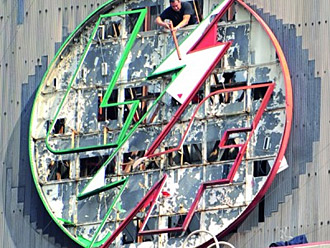
|  |  |  Business News Business News  
‘Electric Storm’, One Year Later
 The News The News
go to original
October 16, 2010


| | (The News) |  |
The Federal Gov’t says the closure of the power company was good for the nation; the union disagrees.

It’s been a year since President Felipe Calderón ordered the closure of Central Light and Power (LyFC), a semi-public electricity company, “as its operations were not convenient for Mexico’s economy and public interests.”

Out of its 44,000 employees, at least 16,000 are still in the fight and 28,000 accepted their severance payments. Over 22,000 retired employees withdraw their pension money on a regular basis. However, two groups are fighting over the control of the Mexican Electrical Workers Union (SME).

The Treasury and Public Finance Secretariat’s (SHCP) Asset Management and Disposition Agency (SAE) assumed the responsibility of the closure process, under the direction of the Energy Secretariat (Sener). Replacing LyFC, the Federal Electricity Commission (CFE) is now providing electricity services.

SURPRISE RAID

On October 10, 2009, around 11:00 p.m., several agents of the Federal Police (PF) simultaneously seized, without violence, LyFC’S headquarters and substations in Mexico City, Morelos, Puebla and Hidalgo. The reasons for the closure of LyFC were listed in the order of dissolution issued by the president on October 11, 2009, which was published that very same day in the Federation’s Official Journal. The order was explained by the Interior Secretary at the time, Fernando Gómez Mont.

The order stated that the LyFC’s percentage of total energy losses was three times greater than that of the CFE. In 2008, LyFC lost 32.5 percent of the energy it bought and sold. In the best-case scenario, the unit prices of the projects carried out by LyFC were 176 percent higher than those of the CFE.

MISSION

The secretariats of Treasury, Energy and Labor had to coordinate their efforts in order to make severance payments as fast as possible.

Severance payments were made in three installments, which included additional money. Employees received a payment over the one established in the Federal Law for Labor and Collective Contracts. Around 28,000 employees voluntarily adhered to this program.

THE FIGHT FOR POWER

The settlement coincided with a complex scenario for the SME, which had held internal elections in mid-2009, in order to renew its Central Committee and its Directorship. Two groups competed over the control of the two departments: one was led by Martín Esparza Flores, and the other by Alejandro Muñoz Reséndiz. The latter did not agree with the final results and challenged the election results, due to alleged irregularities in the process, at the Federal Conciliation and Arbitration Court (JFCA).

The Labor Secretariat’s (STPS) Directory of Associations Registry ruled that the election process had been confusing and that the group led by Esparza could not take over the SME’s Central Committee and the Directorship. The problem within the union was neutralized when the president decided to close LyFC, and both leaders decided to become allies in the fight for their jobs.

A few days later, they broke their pact due to irreconciliable differences, as each one proposed a different way to begin a union battle. The group led by Esparza supported the idea of a legal fight to contest the closure, while Muñoz’s group accepted the severance payment proposal.

LEGAL SOLUTION

The problems caused by the closure of LyFC and its consequences arrived in Congress and the Federal Supreme Court of Justice (SCJN), where the demands of Esparza’s group were analyzed.

The SCJN received a judicial debate against the closure, made by some deputies, while over 150 members of the SME began a hunger strike. However, the SCJN ruled that the decree made by the president was valid and that LyFC would remain closed, which caused intensification of the SME’s demonstrations.

AGREEMENTS

Federal officials and the SME agreed to begin a round of talks in order to revise and establish alternatives to solve the problem. The agreement was signed by the current Interior Secretary, José Francisco Blake Mora; the Labor Secretary, Javier Lozano, and Esparza.

During a general meeting, the SME group led by Esparza said that negotiations were deadlocked and that officials had not found any solutions. They also claimed that they have not received any answer regarding the creation of a new company for the handling of optical fiber, which is the “property” of LyFC.

FIGHTBACK

Blake defended the decree issued by Calderón, arguing that the SCJN validated it, and declared it as legal and constitutional. He claimed that dialogue was the best way to solve the problem between the SME and the federal government. He added that the parties involved will “continue working to find new jobs for the employees of LyFC.”
|

 |
|  |



